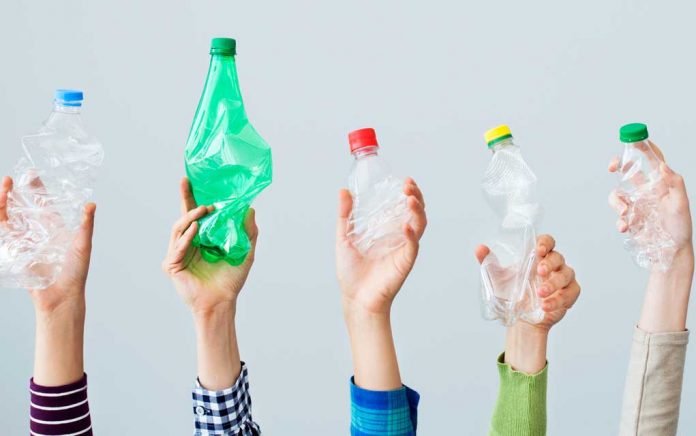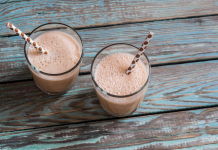
Try visiting the grocery store without buying any plastic. Just about the only things you can buy without some from of plastic packaging is produce (if it's big enough not to warrant a plastic container), and dry items such as flour, sugar and salt.
Many consumers worry about the health effects of bisphenol-A and phthalates, but plastics also pose are a serious threat to the environment.
According to the United Nations Environment Programme, it is estimated there are more than 13,000 pieces of plastic floating on every square kilometer of surface ocean area, and oceanographers have identified a "plastic soup" of garbage floating just below the surface of the water in the Pacific Ocean, stretching from mid-way between San Francisco and Hawaii to the waters off of Japan.
For now, it ultimately comes down to personal choice. The recycling numbers on the bottom of plastic products identify the type of plastic the product is made with. Each plastic is composed of different chemicals including crude oil (with the exception of bioplastics), and some plastics are more likely to leech volatile organic compounds (VOCs) and other toxins than other plastics. Using the recycling numbers, you can make informed decisions about what plastics you feel comfortable using, and which ones you'd rather just leave on store shelves.
#1 PTE (also PETE): polyethylene terephthalate
PTE is a lightweight plastic that can be made semi-rigid or rigid, so it has many applications. It is most commonly manufactured as a fiber (polyester), with plastic bottles accounting for almost all of the remaining global production. It is also used for food trays.
Health
- PET contains DEHA—di-(2-ethylhexyl) adipate—which is an endocrine disruptor, and the EPA classifies it as a possible human carcinogen.
- Studies warn against the reuse of PTE containers, as they can leech phthalates after their initial use.
- Antimony, a toxic metal that can cause damage to the heart muscle, is used in the manufacture of PTE, and concerns remain over whether it leeches into food and beverages.
Environment
- PTE is easily melted down to make fibers, so it's often recycled to make carpets, fiberfill, and fabric for shopping bags.
#2 HDPE: high density polyethylene
High density polyethylene is a thermoplastic that can withstand moderately high temperatures, up to 230ºF, continuously. It is harder and has more tensile strength than low-density polyethylene. Milk jugs, Tyvek mailing envelopes, shampoo bottles, contamination suits and landfill liners are made with HDPE.
Health
- HDPE is generally considered a low health hazard for items with a short shelf life.
- Researchers studying water samples bottled in HDPE containers discovered the containers were responsible for elevated levels of barium and zinc. High levels of barium can affect the nervous system and cause cardiac arrhythmia, while excessive zinc can prevent iron and copper absorption.
Environment
- Between energy and raw materials, it takes 1.75 kilograms of crude oil to make 1 kilogram of HDPE.
#3 PVC: polyvinyl chloride (also called vinyl)
PVC is a commonly plastic, with flexibility ranging from rigid to elastic. Bis(2-ethylhexyl) phthalate, or DEHP, is commonly added to PVC to increase elasticity, and some vinyl materials contain as much as 40 percent DEHP. PVC is used to make shower curtains, plumbing pipe, vinyl flooring and some cling wrap products.
Health
- PVC's main builing block, vinyl chloride, is classified as a carcinogen by the EPA.
- DEHP is an endocrine disruptor, and it may effect development and reproductive processes, particularly in male infants. The EPA classifies DEHP as a probable human carcinogen.
- A study linked PVC flooring and textile wall materials to a doubled risk of bronchial obstruction.
- A 1999 study out of Sweden linked PVC and asthma symptoms in young children, and a follow-up study examining possible links between environment and autism spectrum disordersindicated PVC flooring, and particularly PVC flooring in the parents' bedroom, may be a factor.
Environment
- Chlorine, a component of PVC, is very harmful to wildlife, causing deformities, reproductive damage and death.
- According to Greenpeace, PVC is one of the world's largest sources of dioxins, a group of extremely toxic chemicals. Dioxins are released during manufacturing in a byproduct, ethylene dichloride tars, which are generally dumped or incinerated. More dioxins are released when PVC is burned in residential or industrial fires or as a waste control measure.
- According to Greenpeace, less than 1 percent of PVC is recycled, due to technical difficulties involved in recycling and the associated high cost.
#4 LDPE: low-density polyethylene
LDPE is a lightweight plastic and is much more flexible than HDPE. Bread, frozen food and grocery bags, soda rings, plastic wrap, film for baked goods packaging, coatings on milk cartons and squeeze bottles are all LDPE plastics.
Health
- One of the safer plastics, LDPE is not considered a carcinogen or an endocrine disruptor.
Environment
- These bags can be recycled into new bags or plastic lumber products, but the cost of shipping it to recycling plants is high.
- Seabeds are littered with plastic bags near coastal regions.
- Birds and marine life often become entangled in soda rings and eat plastic bags.
#5 PP: polypropylene
Polypropylene is regarded as the most stable plastic because it has a very high melting point and is resistant to repetitive stress. Yogurt, margarine and other food containers, some cups and reusable food containers, thermal underwear and rope are all made with polypropylene.
Health
- It is not known to leech any chemicals, and is considered one of the safest plastics for human health.
Environment
- Polypropylene production produces several volatile organic compounds (VOCs).
#6 PS: polystyrene
Polystyrene comes in expanded form, which is often referred to by the band name Styrofoam, as well as solid form. Polystyrene is used to make a wide variety of products, including CD cases, disposable utensils, take-out food containers, packing materials, meat trays and bicyle helmets.
Health
- Studies suggest endocrine disrupting chemicals in polystyrene migrate from PS containers into foods when the containers are headed, in microwaves or otherwise.
- When burned, polystyrene releases toxic chemicals, including styrene monomer, benzene, other hydrocarbons and carbon monoxide.
- Research suggests styrene affects the central nervous system in chronically exposed workers.
- Benzene is a volatile organic compound, and a known carcinogen.
- According to the CDC, benzene exposure can harm bone marrow and the immune system, and it can cause a decrease in red blood cells that can lead to amemia. It has also been linked to low birth weights in animals.
Environment
- The cost of shipping and recycling expanded polystyrene (foam) is higher than making new PS from oil, so it's rarely recycled and mostly ends up in landfills.
- When burned, polystyrene releases carbon monoxide and carbon dioxide, which contribute to global warming.
#7 Other
All plastics that don't fit in any of the other categories, or are unknown (usually because they are unlabelled imports) are assigned the number 7. Included in this catch-all category are polycarbonate containers, which contain BPA, and bioplastics made from corn and other plants. Plastic bottle caps, lids, imported containers, polycarbonate baby bottles are just a few of the products that fall under the number 7 category.
Health
- These are miscellaneous plastics, so the health effects vary widely.
- BPA is an essential building block of polycarbonate plastics, and there is growing concern about the potential for this chemical to act as an endocrine disruptor and to impact reproductive health.
Environment
- Number 7 plastics are rarely recycled because they could contain any number of chemicals. Unless a company has their own take-back recycling program (such as Aveda's bottle caps program), you can pretty much guarantee they'll end up in landfills.










